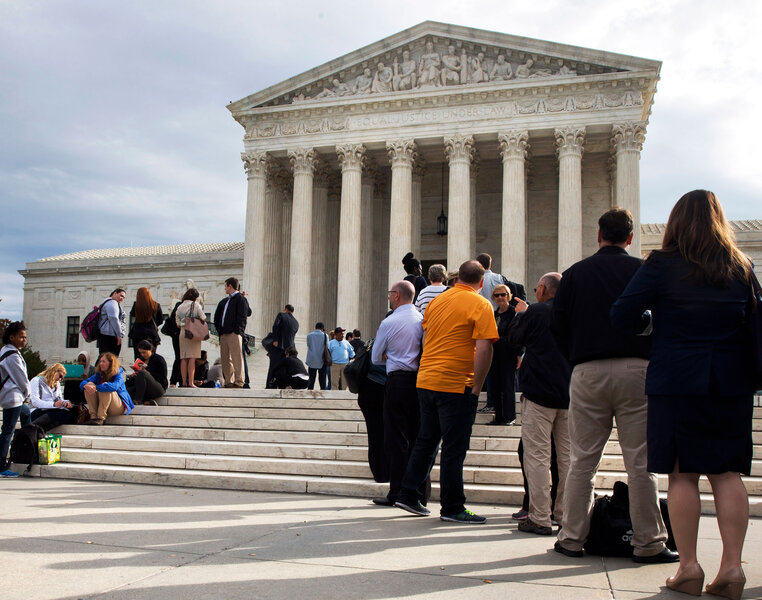Supreme Court displays its 'evolution' in ruling on juvenile life sentences
Loading...
The United States Supreme Court has declared invalid a portion of every sentence nationwide that imposed a mandatory punishment of life in prison without the possibility of parole for those who committed their crimes as juveniles.
Instead, the high court declared that such inmates – despite their sentences – must be given an opportunity to win their freedom through parole.
In a 6-to-3 decision, the justices extended a 2012 opinion that said sentences that automatically impose life without parole on a juvenile offender are unconstitutionally cruel in violation of the Eighth Amendment.
On Monday, the high court applied that 2012 ruling retroactively to anyone who was already serving a sentence of life without parole for a crime committed at age 17 or younger.
There are more than 2,300 such inmates in the US currently serving life-without-parole sentences, according to the Phillips Black Project, a public interest law group that litigates on behalf of inmates.
The decision does not mean that those convictions are no longer valid. And it does not necessarily mean that lower courts will now have to resentence each offender.
In his majority opinion, Justice Anthony Kennedy said that states can remedy the constitutional violation by permitting juvenile homicide offenders an opportunity to be considered for parole.
“Allowing those offenders to be considered for parole ensures that juveniles whose crimes reflected only transient immaturity – and who have since matured – will not be forced to serve a disproportionate sentence in violation of the Eighth Amendment,” Justice Kennedy wrote.
“Extending parole eligibility to juvenile offenders does not impose an onerous burden on the states, nor does it disturb the finality of state convictions,” Kennedy said.
“Those prisoners who have shown an inability to reform will continue to serve life sentences,” he wrote. “The opportunity for release will be afforded to those who demonstrate the truth [of the court’s 2012 decision] – that children who commit even heinous crimes are capable of change.”
Defining cruel and unusual punishment
The essence of the court’s decision is that even people who commit the most horrific crimes in their youth may someday grow and mature into individuals entitled to regain their freedom. As the court has put it: “children are constitutionally different from adults in their level of culpability.”
The holding is part of a trend in the high court’s Eighth Amendment jurisprudence that has expanded the concept of what is cruel and unusual punishment. For example, the justices have declared it unconstitutional to execute a juvenile offender and offenders with mental disabilities.
In 2012, the court extended those holdings to bar mandatory sentences of life without parole to juvenile offenders. Monday’s decision is a further extension of that decision.
In a dissent, Justice Antonin Scalia said the court was distorting the court’s 2012 opinion.
“This whole exercise ... is just a devious way of eliminating life without parole for juvenile offenders,” he wrote in a dissent joined by Justices Clarence Thomas and Samuel Alito.
Joining Kennedy in the majority were Chief Justice John Roberts and Justices Ruth Bader Ginsburg, Stephen Breyer, Sonia Sotomayor, and Elena Kagan.
The Montgomery case
The decision comes in the case of Henry Montgomery, an almost 70-year-old inmate in Louisiana serving a life sentence without the possibility of parole for the fatal shooting of a deputy sheriff in East Baton Rouge.
The shooting took place in 1963. Mr. Montgomery was 17 years old at the time.
Montgomery was placed on trial, convicted, and sentenced to death. That conviction was later overturned in light of extreme racial overtones during his trial. Montgomery is black; the deputy sheriff was white.
A second trial also resulted in a conviction, but the jury did not vote for a death sentence. Under Louisiana law, Montgomery received an automatic sentence of life without parole.
In its 2012 decision, the Supreme Court said that judges cannot automatically sentence juvenile offenders to life without parole. Instead, there must be an individual assessment of mitigating factors – considering the defendant’s youth and immaturity at the time of the offense.
Since this did not happen in Montgomery’s case, the high court ruled, he is now entitled to be considered for parole.
Kennedy said that Montgomery now claims, after 46 years in prison, to have evolved from a troubled, misguided youth into a model inmate. Montgomery says he helped establish a prison boxing team, is active in the prison silkscreen department, and is a positive role model to other inmates.
“These claims have not been tested or even addressed by the state, so the court does not confirm their accuracy,” Kennedy said. But such submissions are relevant as an example of the kind of evidence a prisoner could use to demonstrate rehabilitation, Kennedy said.
“Henry Montgomery has spent each day of the past 46 years knowing he was condemned to die in prison,” Kennedy wrote.
The justice said that perhaps there might be a showing of exceptional circumstances that would demonstrate Montgomery’s harsh sentence was just and proportionate for a teenage offender. But Kennedy added that given the court’s evolving understanding about the culpability of young offenders, “prisoners like Montgomery must be given the opportunity to show their crime did not reflect irreparable corruption.”
If not, Kennedy said, “their hope for some years of life outside prison walls must be restored.”
Montgomery’s lawyer, Mark Plaisance, said he was pleased by the high court’s decision.
“This is just the first step in a long process for Mr. Montgomery,” said Mr. Plaisance, the public defender from East Baton Rouge Parish who argued the case at the Supreme Court.
“Today’s decision simply provides an opportunity for review,” Plaisance said. “It is our hope that state courts will now follow the lead of our highest court and a majority of other states around the country and give those convicted of crimes as youth a chance to become productive citizens.”
The case was Montgomery v. Louisiana (14-280).







